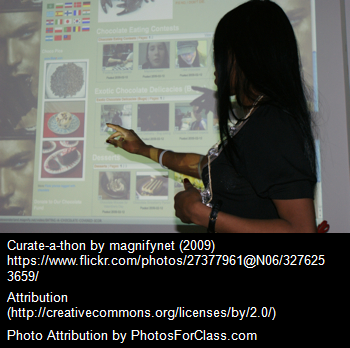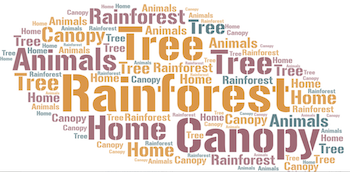1.2 Reading Projects: Unit 1
| Site: | Cowichan Valley School District - Moodle |
| Course: | ELA6, CSS, Sferrazza |
| Book: | 1.2 Reading Projects: Unit 1 |
| Printed by: | Guest user |
| Date: | Tuesday, 16 December 2025, 4:34 AM |
Overview

How do you like to show your learning?
- Text?
- Art?
- Audio?
- Video?
- A combination?
Now that you have completed the readings and learning guide activities, hopefully you have an understanding about what it is to have a "sense of place". Keeping in mind the focus: "sense of place", choose one of the following choices and continue on to the appropriate page for more detail.
With your home facilitator, review all three options (explained on the next three pages) and together, choose one that you would like to complete.
|
Challenge Level: |
Choices: |
| Easy (if you like art) - Medium | Responding with Art and Words |
| Medium | Curate-a-Thon |
| Challenging | Destination Your Town |
Choice 1: Responding with Art and Words
The Great Kapok Tree is a children's picture book about rainforest conservation. It was written and illustrated by Lynne Cherry in 1990. The book is dedicated to Chico Mendes, a Brazilian environmental activist. Listen to the video excerpt from The Great Kapok Tree by Lynne Cherry. You can listen to it as many times as needed, but listen to it at least three times. While listening the second and third time:
Take Notes: On a regular sheet of paper, take point form notes of details from listening to the video that would help you to create a picture of this tree.
Illustrate:
Then, draw and colour, paint, or create a art piece that shows what comes to mind as you hear the words.
Write:
Finally, write a paragraph about what you chose to put in your picture and why. Your paragraph will have a topic sentence, at least four supporting details, and a concluding sentence.
(Source: Bass, Phyllis. The Great Kapok Tree. Frank Schaffer Publications, 1994.)
Marks:
Ideas: Your art reflects the mood and content of the story.
Word Choice: Notes are included. Description uses notes and includes sensory details (sight, smell, taste, texture, and sound) and includes some figurative language.
Organization: Neat, effort is evident.
Conventions: Point form notes show effort to edit for spelling. Paragraph shows effort to edit for capitals, usage, punctuation, and spelling.
Choice 2: Curate-a-Thon
 To curate something means to collect, organize, look after, and display or share a collection of some kind. Art curators curate art. Museum curators cure historical artifacts. A content curator is someone who finds, groups, organizes and shares the best and most relevant content on a specific issue.
To curate something means to collect, organize, look after, and display or share a collection of some kind. Art curators curate art. Museum curators cure historical artifacts. A content curator is someone who finds, groups, organizes and shares the best and most relevant content on a specific issue.
Create a curated collection either based on "The Great Kapok Tree" (video found under choice one), a place to which you feel a strong connection (you could even take photos or video there to include in your curation), a place in a favourite movie (ie the woods in Bridge to Terabithia), or a favourite story with a special location. Your collection could include artwork, images / photos (close ups of special objects, zoomed out for "big picture"), sketches, and words that connect to the topic. Your collection will be curated (organized with a focus) by including creative descriptions, descriptive labels, quotes from the text about the place, or a short poem reflecting each object. Your collection can be submitted in a:
- powerpoint
- word processing document with images
- sketchbook or hand created entries (you can take photos of your work, put them into a single document, and submit online OR you can send it/show it to your teacher.)
- images of a display (objects and text) put together
- a video your items with recorded audio
- poster
- blog (if your family has a site where you can do this)
Ideas and Content:
Your collection will be curated (organized with a focus) by including descriptions of each object, or a poem that includes each object, an essay, or other descriptive labeling.
- Each object, drawing, or image reflects something special or meaningful about the story text or your special place.
- Each object, drawing, or image has a description, label, caption, or even a short poem that explains the choice and how it connects to the topic.
Organization: Include a minimum of five objects that reflect the place and feelings about it (either based on "The Great Kapok Tree" or from a single place of importance in another text or movie). The collection should be titled and be organized in a logical way.
Conventions: Writing and presentation is clear and correct capitals and punctuation are used.
Some links for inspiration if you need:
Additional Ideas:
Include word art that shows how you or a character feels about your chosen setting or an item in your collection. You can use without creating an account. Type in your words on the left, click on visualize, and experiment with other options, always clicking on visualize when you want to see the impact of your changes. When you have created your art, you can take a screenshot or choose PRINT and SAVE AS PDF or JPG.

Marks:
Ideas: Your collection will be curated (organized with a focus) by including creative descriptions of each object, or with a poem that includes each object, or essay, or other creative labeling.
Word Choice: Use sensory details (sight, smell, taste, texture, and sound) and includes some figurative language.
Organization: Include a minimum of five objects that show a sense of place. The collection should be titled and be organized in a logical way.
Conventions: Writing or oral presentation is clear and correct punctuation is used (if written) or clear speaking, good expression, and voice that matches mood are used (if spoken/audio recorded).
Choice 3: Destination Your Town
After watching and reflecting on a few "Destination BC" videos, make a "Destination Your Town" video. This does not need to be really long. Capturing good video and editing video takes a long time. Many of the "Destination BC" videos are 1:00 - 2:00 minutes.
From the link below, suggested examples that show a strong connection to place include:
- Telegraph Cove on BCs Vancouver Island
- Ranching at Watch Lake BC
- Fort Nelson BC
- Music Meets Nature in Kamloops BC
But you can watch any that interest you.
Here is the link to the DESTINATION BC youtube channel:
After you've watched a few, think of how you could show one - three special things about your town or you can zoom in one one special location, even in or around your house. Using a smart phone or camera, take some images and videos you can include in a video. You may decide to record your speaking after you have collected bits and pieces, or you may make a script to follow while on location.
Put together a one to two minute video. If you have help or can figure out how to use a movie editing software or app, you can add an introduction (title, actors) at the beginning and credits at the end.
Marks:
Ideas and Content: Choose strong video / photo clips that show what gives you a strong sense of place.
Word Choice: Use sensory details (sight, smell, taste, texture, and sound) and includes some figurative language.
Organization: Thought and planning is clear. Images and video are thoughtfully organized, possible spatially or chronologically if it suits presentation.
Audio: Clear speaking. Good expression. Voice matches mood.

